|
|
|
Sort Order |
|
|
|
Items / Page
|
|
|
|
|
|
|
| Srl | Item |
| 1 |
ID:
147843
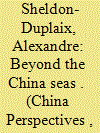

|
|
|
|
|
| Summary/Abstract |
In May 2015, the Information Office of the State Council published a new white paper on China’s military strategy stating that “overseas interests [had become] an imminent issue.” Accordingly, China has embarked on a build-up aimed at making itself into a “sea power,” mainly in the Indo-Pacific region, in order to deter a US intervention in Taiwan and to protect its trade in the Indian Ocean. China has acquired a medium-sized aircraft carrier with a tenth of the capability of a US super-carrier and is learning the ropes as fast as the more experienced and poorer Russia did in the early 1990s. As a source of pride to its citizens, China’s aircraft carrier program plays into the hands of the Communist Party to demonstrate its legitimacy and success. And yet, China has not yet tried to challenge the superiority of the US Navy on the “far seas.” With three or four carriers, China will remain a regional navy with global reach leading India, the UK, and France at that level.
|
|
|
|
|
|
|
|
|
|
|
|
|
|
|
|
| 2 |
ID:
192295
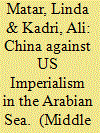

|
|
|
|
|
| Summary/Abstract |
When Oman joined China’s Belt and Road Initiative to pursue economic diversification, the US intervened to stop it. Although the foundation stone for Chinese investment plans was laid in 2017, these projects were put on hold, while the US rushed to bolster its military presence in Oman. The article studies Chinese investment in Oman, accounts for what has developed so far, and highlights the reasons for which the US acted to stem the potential of non-oil development in Oman. The disruption of the China-Oman diversification project resembles the US’s targeting of China’s policy of expansion by mutual cooperation elsewhere, but with a twist: Oman sits close to two vital chokepoints, the Bab Al-Mandeb and the Hormuz straits. The article argues that such obstruction is central to the US’s mode of accumulation by militarism. Keeping Oman from auto-developing and building its autonomy makes of it a pliable client state ready to serve as an imperialist post to empire.
|
|
|
|
|
|
|
|
|
|
|
|
|
|
|
|
| 3 |
ID:
147400
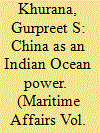

|
|
|
|
|
| Summary/Abstract |
Lately, China’s politico-diplomatic and economic engagements with the Indian Ocean littorals, and its naval activities in the region, have become increasingly conspicuous. This paper aims to undertake a comprehensive assessment, not only of the trends, but also of the underlying factors shaping these trends, which makes China potentially an Indian Ocean power. The underlying factors examined are China's economic, strategic and geopolitical objectives and imperatives, and its national strategy – including its maritime military strategy – in the region. The paper concludes with a prognosis, and its implications for the region and India.
|
|
|
|
|
|
|
|
|
|
|
|
|
|
|
|
| 4 |
ID:
163626
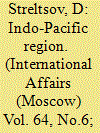

|
|
|
| 5 |
ID:
179951


|
|
|
|
|
| Summary/Abstract |
Since the launch of the Maritime Silk Road Initiative (MSRI), observers have witnessed the consolidation of a growing Chinese presence in ports around the Indian Ocean Region (IOR). This growing presence has caused alarm among skeptics who view the MSRI as a second coming of the String of Pearls (SoP). Indeed, China is seen as leveraging MSRI port investments in return for national strategic and geopolitical gain, such as ultimately gaining a military foothold in MSRI ports. Regardless of China’s purported intent, this paper seeks to add nuance to this debate by examining whether Beijing can actually achieve such strategic gains in the IOR via the deployment of its economic statecraft (via MSRI investments). As the paper shows, the MSRI’s current rollout – as well as the inherent resistance to the strategic dimensions of this rollout – offer little in the way of empirical support to the SoP concept.
|
|
|
|
|
|
|
|
|
|
|
|
|
|
|
|
| 6 |
ID:
160495
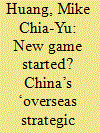

|
|
|
|
|
| Summary/Abstract |
China’s port facility construction projects in the Indian Ocean (IO) region, particularly those in Gwadar and Djibouti, have led to a heated debate among strategists over whether the country has been carrying out a ‘string of pearls’ strategy, an alleged Chinese scheme to challenge America’s military predominance in South Asia. Although Beijing has denied the existence of such a strategy, it has enhanced its strategic ties with littoral countries in the IO region over the past few years. This article discusses the evolution of Beijing’s IO strategy and examines the nature of these Chinese port projects. It argues that rather than simply copying the American model of developing military bases overseas, China has been deliberating a more sophisticated plan for its physical presence there—creating a new set of ‘overseas strategic pivots’. These ‘pivots’ are designed to help Beijing sustain its anti-piracy campaign and serve as forward stations for the transportation of China’s imported energy and merchandise while, with a relatively low-key stance, reducing any unnecessary opposing actions by rival powers. In addition, their political and economic functions are to a certain extent greater than their military functions despite the fact that they appear to be military bases. More importantly, these ‘pivots’ can help China create closer partnerships with littoral governments in the IO region, which suggests that the country is trying to create a friendly international environment favouring its plan to step into the global maritime domain.
|
|
|
|
|
|
|
|
|
|
|
|
|
|
|
|
| 7 |
ID:
169956
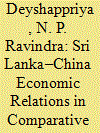

|
|
|
|
|
| Summary/Abstract |
The article examines recent trends in the economic relations between Sri Lanka and China focussing on trade, investment and tourism dimensions. Although bilateral economic ties between Sri Lanka and China have strengthened over time, the article demonstrates Sri Lanka’s low rank among China’s economic partners. For example, while China is the second-largest tourism partner of Sri Lanka in terms of tourist arrivals, Sri Lanka does not rank among even China’s top 25 tourist destinations.
Consequently, the article recommends certain policy priorities to ensure mutually beneficial economic relations. With regards to tourism, it recommends promoting Sri Lanka’s brand on Chinese e-tourism websites and social media, introducing user-friendly tourist apps in Chinese, strengthening air connectivity and celebrating Chinese festivals. Similarly, trade and investment could be facilitated by stronger links with Chinese cities and connecting Sri Lankan students in China to the Chinese industry via internships and building commercial networks from the ground up.
|
|
|
|
|
|
|
|
|
|
|
|
|
|
|
|
| 8 |
ID:
112746
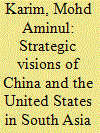

|
|
|
|
|
| Publication |
2012.
|
| Summary/Abstract |
China and the United States are the greatest strategic powers of the world today, where
China is rising but the United States still remains predominant. Both have their grand
strategic visions to shape and manage the world or regional political and security
architecture. South Asia, being located in a critical and important geographical area,
with players such as India, Pakistan, and others, is factored in their visions. It gives
rise to a different combination of alignments and orientations of the states of South
Asia and beyond. A kind of power game, along with its tangible manifestations, also
seems conspicuous. This paper attempts to develop a broad framework of such
developments, along with ramifications, both in place and projected, in the political
power games of the relevant actors in South Asia.
|
|
|
|
|
|
|
|
|
|
|
|
|
|
|
|
| 9 |
ID:
086091
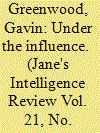

|
|
|
|
|
|
|
|